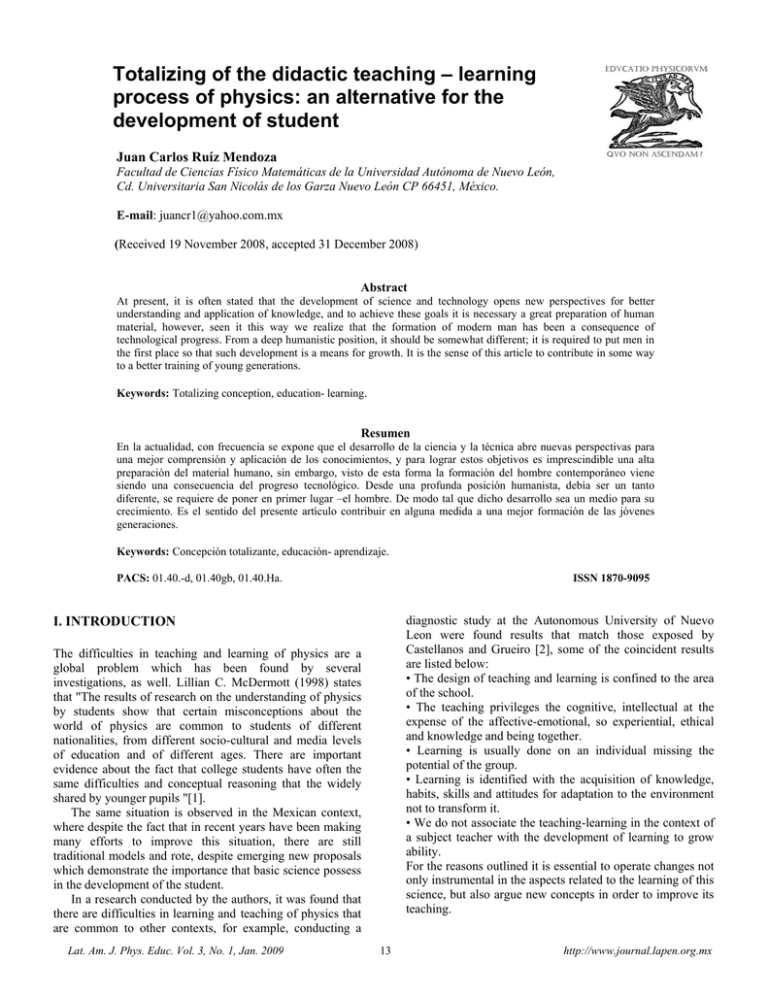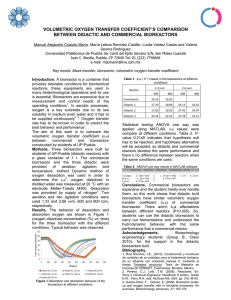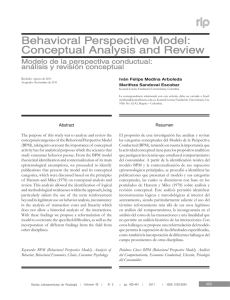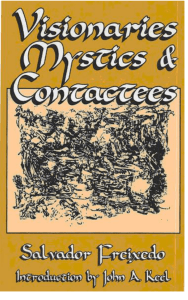Totalizing of the didactic teaching – learning process of physics: an
Anuncio

Totalizing of the didactic teaching – learning process of physics: an alternative for the development of student Juan Carlos Ruíz Mendoza Facultad de Ciencias Físico Matemáticas de la Universidad Autónoma de Nuevo León, Cd. Universitaria San Nicolás de los Garza Nuevo León CP 66451, México. E-mail: [email protected] (Received 19 November 2008, accepted 31 December 2008) Abstract At present, it is often stated that the development of science and technology opens new perspectives for better understanding and application of knowledge, and to achieve these goals it is necessary a great preparation of human material, however, seen it this way we realize that the formation of modern man has been a consequence of technological progress. From a deep humanistic position, it should be somewhat different; it is required to put men in the first place so that such development is a means for growth. It is the sense of this article to contribute in some way to a better training of young generations. Keywords: Totalizing conception, education- learning. Resumen En la actualidad, con frecuencia se expone que el desarrollo de la ciencia y la técnica abre nuevas perspectivas para una mejor comprensión y aplicación de los conocimientos, y para lograr estos objetivos es imprescindible una alta preparación del material humano, sin embargo, visto de esta forma la formación del hombre contemporáneo viene siendo una consecuencia del progreso tecnológico. Desde una profunda posición humanista, debía ser un tanto diferente, se requiere de poner en primer lugar –el hombre. De modo tal que dicho desarrollo sea un medio para su crecimiento. Es el sentido del presente artículo contribuir en alguna medida a una mejor formación de las jóvenes generaciones. Keywords: Concepción totalizante, educación- aprendizaje. PACS: 01.40.-d, 01.40gb, 01.40.Ha. ISSN 1870-9095 diagnostic study at the Autonomous University of Nuevo Leon were found results that match those exposed by Castellanos and Grueiro [2], some of the coincident results are listed below: • The design of teaching and learning is confined to the area of the school. • The teaching privileges the cognitive, intellectual at the expense of the affective-emotional, so experiential, ethical and knowledge and being together. • Learning is usually done on an individual missing the potential of the group. • Learning is identified with the acquisition of knowledge, habits, skills and attitudes for adaptation to the environment not to transform it. • We do not associate the teaching-learning in the context of a subject teacher with the development of learning to grow ability. For the reasons outlined it is essential to operate changes not only instrumental in the aspects related to the learning of this science, but also argue new concepts in order to improve its teaching. I. INTRODUCTION The difficulties in teaching and learning of physics are a global problem which has been found by several investigations, as well. Lillian C. McDermott (1998) states that "The results of research on the understanding of physics by students show that certain misconceptions about the world of physics are common to students of different nationalities, from different socio-cultural and media levels of education and of different ages. There are important evidence about the fact that college students have often the same difficulties and conceptual reasoning that the widely shared by younger pupils "[1]. The same situation is observed in the Mexican context, where despite the fact that in recent years have been making many efforts to improve this situation, there are still traditional models and rote, despite emerging new proposals which demonstrate the importance that basic science possess in the development of the student. In a research conducted by the authors, it was found that there are difficulties in learning and teaching of physics that are common to other contexts, for example, conducting a Lat. Am. J. Phys. Educ. Vol. 3, No. 1, Jan. 2009 13 http://www.journal.lapen.org.mx Juan Carlos Ruíz Mendoza of knowledge, which allows the person to pass from the real knowledge he possesses, to a more abstract knowledge and to other levels. Transcendence is achieved through a thought and a transforming action of reality [5]. II. ARGUMENTATION OF THE TOTALIZING CONCEPTION DIDACTIC In surveys to teachers who teach Physics, the following results were obtained [3], according to responses from the respondents: The lessons of Physics are developed through the explanation of the content (90%), using active methods (5%) the develop of the classes is based on spontaneity, experience, and the memory of how they learned and how their teachers acted (89%), the teaching and learning of physics does not link theory with practice (65%) use of experimentation in class (5%) use of ICT for teaching physics (3%) the process of teaching -learning allows: only educate students (80%), only educate the student (0%) educate and instruct students (5%). In addition there is a great heterogeneity in the teachers who teach physics: engineers of various specialties, doctors, and graduates from other professions. It was found through a survey of students, that from a sample of 345 students from the Autonomous University of Nuevo Leon of engineering and physics, only 24.5% said that there is a relationship of physics to life, the rest identified it with the reproduction of what has been learned and 75.2% said a narrow conception of learning expressing that the development of feelings, attitudes and values are accomplished outside school and in lessons of Physics, one only learns the art. These results correspond to those set out above, showing the difficulties outlined. The Didactic totalizing conception presented in this article is directed to a more transcendent understanding of the teaching-learning process of physics. It is based on the paradigm of systemic structural investigation [4]. This approach considers the whole constitutes a dialectical unity of its components and that the properties of the system are qualitatively different from the properties of these components separately are synthesis of the relations between the components or subsystems of all, characterizing the system and its development. The features of the structural systemic method helped identifying all the group of elements which are components of the design, and the relationship of significance within the different subsystems that integrate it. These relationships of significance in the case of this study are not of hierarchy and subordination, but rather of interaction, provide coherence to the system components. The essential budgets of the theoretical and methodological concept hold are as follows: B. The link between theory and practice as a pathway for the integral study of the physical phenomenon The author in his experience for more than 20 years as a professor has acknowledged that in a lecture, still when it is a matter of following the logic of scientific investigation, the physical phenomena are studied frequently in an incomplete way, since the same alone are only described and explained on part of the professor and the students reproduce what is listened or read. On the other hand, it is common to study the theory, then problems are solved and in the final laboratory practice and experimentation are developed. The time between one activity and the other could cause a breakdown in understanding the external manifestation of the phenomenon and its essence. In this research the benefits that own the study of the phenomenon in all its physical integrity were taken into account, in every teaching activity of 3 hours. To achieve the before mentioned is taken into account the physical phenomena integral way of expressing, that total way states that in its study is very important to take into account the logic. In that way in the education ambient or in a system of activities its possible to comply with three essential moments that correspond with the stated: the observation, to understand how the phenomena manifests, the penetration in its regularities by modeling the phenomena and the verification through the experimental activity. What is expressed before can be summarized in the next scheme. SCHEME 1. Interrelation of the ways and moments of learning the physical phenomena. Manifestation of the physical phenomenon Software uses A. The transcendent character which the teaching and learning process must possess Experimental research At present, in light of new transformations that take place in the learning process for students, it is important the enhancement of the teaching act. The author of this investigation starts in the transcendent character that the teaching process must possess, understanding transcendent as the essential quality required to hold the teaching-learning process, which goes beyond the study of a particular branch Lat. Am. J. Phys. Educ. Vol. 3, No. 1, Jan. 2009 Observation of reality (external manifestation) Virtual modeling of the phenomenon (An approach to the internal demonstration ) Verification of the result (A comprehensive understanding of the phenomenon) C. The unity of education and instruction for the development of the student If the study of a particular area is not developed from a training approach, nowadays it makes little sense. In 14 http://www.journal.lapen.org.mx Totalizing of the didactic teaching – learning process of physics: an alternative for the development of student conjunction with the acquisition of knowledge, skills and habits of each subject it is necessary to develop an active and transforming position and of students toward life, for this it is require to direct attention to those areas of the personality that found its realization in all spheres of human activity. If we combine the consideration of the physics characteristics as the science of nature with all the potential offered by its teaching and learning process (that is not any process) we can determine some guidelines for the training desired: A good education is one that exceeds the limits of a subject of a science, a field of knowledge [6]. The principle of unity of instructional and educational based on the cognitive-affective aspects, is the key to the appropriation of the modes of action that students acquire their relations under the aegis of the teacher. Proper linkage of the content of education with the interests, emotions, feelings that for the cognoscente have meaning, promotes and enhances the development of the integrated personality. By promoting a proper self-esteem and confidence in himself in students, among countless ways, this is possible through the structuring of the teaching-learning process not only focused on the task, but with emphasis on students, because not all have the same possibilities. On many occasions, there are classes of Physics Students with low academic performance, which may be a cause of low selfesteem. It is also important to consider for achieving the unity of instructional and educational impact that has values education. Is due to reveal in a explicit way to students the meanings of values, its systemic nature, guide them in the identification of values, since they must know how to respond and not to everything that comes from abroad in terms of fashion, prejudice and views. Discuss with the students about to assume responsibility is not fulfilling certain duties, is to capture the values it embodies, its meaning and relevance. It is about taking advantage of all the possibilities of Physics as a science, as well to the didactic process as a relational and communicative process to be able to influence in a more significant formation that is not limited to work for the assimilation of meaning through the Physics conceptual system. The process of study of Physics, its extensive applications, the relationship with life, the possibility for the development of interpretation, explanation and argument (that has a application in all human spheres of student’s development), allows that this discipline can take a positive meaning, that is motivational and educational for the students. The results of the diagnostic study, the analysis of the theoretical sources and the author experience, permitted to support a conception based on a systematic focus where the integral formation as a system of greater order integrates other systems, at the same time these are composed by components that are interrelated among itself. Next the interrelationship between each one are explained (Fig. 1). FIGURA 1. Subsystems and components for the design didactic all-round education for students through the process of teaching and learning of Physics. The system design that classifies the teaching totalizing (Annex 1) consists of the subsystems conceptual training Lat. Am. J. Phys. Educ. Vol. 3, No. 1, Jan. 2009 methodology, the cultural education and training as a synthesis of the two previous ones, are dynamic by the 15 http://www.journal.lapen.org.mx Juan Carlos Ruíz Mendoza fundamental contradiction that directs the current investigation, which is established between the construction of meanings and manifested between the epistemological sense of physics and its connotation in the personal and the social [7]. methods and means of each item that integrate the different programs, which despite possessing specific characteristics have a sense of belonging to the conceptual general physical system. The appropriation of knowledge must take place in a dialectical unity with the domain of procedures and strategies for learning, in a way that is conducive to the development of levels of consciousness, where the conceptual system acquires a personal sense for the student, in addition to understand its significance for social development. In the educational practice has not been able to overcome the so-called "transfer of knowledge" based on a formal explanatory logic, which prevents the teachinglearning process to postule an epistemology that allows for the seizure and in for reality. In this subsystem is very important to encourage an investigative process which the unity between the theoretical, the conceptual is developed, the ways to achieve this and checking if it is useful in practice. The research tasks that are available to students develop the flexibility of thinking, their creative abilities, prepares them to transform reality. On many occasions troubleshooting is so mechanical that a student can solve a problem correctly from the quantitative, but does not know to explain the essence of physical phenomenon, the laws or categories that sustain it [12]. To achieve a proper relationship between meanings and senses, it is essential the unity of theory with practice. To do this, it is not sufficient to substantiate an experiment by the phenomenon and physical laws, nor the conduct of scientific work; it is needed in every moment of teaching, from its own dynamic to take this fact into account so this will achieve the necessary flexibility in the student. If this flexibility is not achieved, then students can not shed the preconceptions they have. In the manifestation of physical phenomenon in nature and the potential of the teaching-learning process, there is a contradiction, because when students observed a physical phenomenon can have a distorted perception or incomplete, even though the observation is properly planned, however , In the teaching-learning process there are all possibilities to study the phenomenon in its external manifestation, but also to know the why of this event, its causes, often this potential is not taken in advantage. The second subsystem related to the cultural education is integrated by the components: gnoseologic logic of physics and the integrated interpretative logic, dinamised by the relationship of physics with life. The first component: the gnoseologic logic of physics is needed as a theoretical construct related to the specific characteristics of this science that indicate how the physical phenomenon should be studied and systematized from general principles and laws. The second component: the integrated interpretative logic is related to that theoretical construct that indicates the fact that the significant observations did not appear without generalized knowledge. The interpretive process as part of that logic studies the movement from all to the parts and from the parts to all. For the study of physics from this III. III. ANALYSIS OF COMPONENTS AND SUBSYSTEMS The training methodology is conceptually related to the acquisition of knowledge, habits, skills and abilities that the student will acquire through the study of the various courses of physics at the middle level, in conjunction with the dominance of the conceptual apparatus the student must be appropriating the methods, means and procedures of this science and that in turn can be transferred to the study of other branches of knowledge [8]. Cultural formation is one that relates to the acquisition of the experience accumulated by humanity in different orders that allows the student to interpret and transform reality through the study of physics and its relationship to life [9]. The integral training constitutes the synthesis of the methodological and conceptual training cultural formation that has its manifestation in a student's preparation in correspondence with the individual and social needs [10]. It argued previously has an enormous value for the didactic process, indicates the importance to create the spaces for the construction of the meanings and senses in narrow relation because before specific conditions, the not coincidence among them can give them a truly alien character and even of mutual comparison, for example when he is capable of resolving well a problem but not the importance of an adequate comprehension can be explained And resolution. The matching between the meaning and senses that is oriented and linked to the humanization of the learningteaching process when takes into account the student as the most important element helps in its integral formation, together with his cognitive development. One of the contradictions that are manifested in the teaching-learning process, is between the social requirements that requires people active, creative, transformative people and reproductive learning of physics, this learning is in contradiction with the reproductive characteristics of an apprenticeship training [11]. The subsystems are composed of components also in interrelation with each other. Here are the interrelationships between each one. The first subsystem, related to the conceptual methodology training is composed of conceptual components: the physical conceptual system and the specific physics content, which energizes the whole-part relationship. The first component: the physical conceptual system is determined by the system of knowledge, skills, work strategies of the subject, methods and means for learning, including in the different programs of higher average level that identify themselves as a whole. The second component related to the specific physical content is identified with the system of knowledge, skills, Lat. Am. J. Phys. Educ. Vol. 3, No. 1, Jan. 2009 16 http://www.journal.lapen.org.mx Totalizing of the didactic teaching – learning process of physics: an alternative for the development of student interpretative logic, the unity of the process of observation and interpretation could be understood. The logic gnoseologic of physics states that for the understanding of its conceptual apparatus, it is imperative to take into consideration a range of activities, processes and methods, such as monitoring, modeling, testing, among others. For example, teaching to observe is equal to conscience awake to the multiple meanings of the environment. It involves fixing the attention, applying an interpretative logic that integrates the discrimination of elements, their interrelationships and their interpretation from them, from this perspective can be seen by the student as a literary text, a mathematical problem, a physical phenomenon, a social situation or a work of art. The interpretative logic allows the student to interpret the world around him as a whole from different forms and methods of knowledge that are unique of the gnoseologic characteristics of Physics. The demonstration between theory and practice constitutes the dynamic element of this subsystem because it requires a certain flexibility in order to understand the reality which causes a significant axiological. The gneseologic characteristics of physics constitute an inexhaustible potential for development of the student, but they gain a true sense when applied not only in the field of physics but also to the understanding, explanation and reasoning of other phenomenon of nature and society. The very nature of this science enables the development of the argument and interpretation on the students, relying on facts, concepts and theories, using the right information, assessing the advantages and disadvantages, contrasting views on improvements and problems that occur in the applications of Physics. For example, the use of different energy sources for obtaining electricity, the use of radioactive isotopes, the use of nuclear energy in this manner he is capable of linking scientific, technological, economic and social issues. This explains why when we interpret the physical phenomenon; this ability can be transferred to other phenomenon and other areas of performance and knowledge. When studying physics and it is understood by students, it propagates in them a transforming thought of reality, therefore, not only is it possible to develop logical thinking skills, build a conceptual change in students, but also their culture can be extended. Moreover, the history of physics, its development expressed in different paradigms, broadens the student's cultural knowledge, familiarity with the lives of great physicists, their attitudes copies, allowing help to enrich the look axiological. These potentials of Physics, in practice are minimized, because teachers in many cases are permeated by the idea that their role is to make students “learn physics” therefore it is not seen as a source for the acquisition of culture. Many years ago a very clear Erwin Schrödinger pointed out the relationship of science and culture, in this connection expressed "the tendency to forget that science is linked to human culture in general, and that the scientific findings, like those that in a moment appear to be the most advanced, esoteric and difficult to grasp, lose their meaning outside any cultural context "(quoted by Roger Stuewer) [13]. Lat. Am. J. Phys. Educ. Vol. 3, No. 1, Jan. 2009 If there is a proper linking between theory and practice we get flexibility to understand the reality that goes beyond the verification of facts and events, such flexibility is what allows transcendence axiological, social processes for example, require a flexible and open minded. The didactic flexibility has to be manifested on the possibility that the student is free at some point, to propose alternatives, so this way students and teachers harmonize so the teacher stops being the absolute protagonist. The third subsystem, related training, which is the synthesis of the previous two components has the potential of Physics and the potential of teaching and learning process and stimulate the relationship Science and Physical ScienceDidactics. The significance ranging from the unity of meanings and senses favors axiological addition to the cognitive aspect, is characterized by what look different as established by the flexibility of thinking. "The significance is achieved through thinking and action of transforming reality, including the subject" [14]. When the student not only plays, but understands and questioned, analyzed, certainly appreciates is shaped in the same axiological aspect. In this case, if the teaching-learning process of physics is concentrated only in the student learns his conceptual apparatus, without finding their way, then it is a training partial, incomplete, not transcendent. The publications of Álvarez, et al., [15] about the integral formation of the student help to understand that the didactic science, since its own object can favor the necessary spaces for the construction of the meanings unit and the senses in the students. If this relation doesn’t become aware on part of the professors or its disciples, you can not achieve a formation that transcends the borders of any of the school subjects among them of course the Physics. The problem of the scientific content has been sufficiently taken in the didactic and pedagogical literature, [16] its reaching and place in the formative process of the students. When the learning of a discipline is privileged without the student having clarity of the why and what for this studies are, an incomplete fragmented knowledge is obtained, if then one agree that "knowledge is action" and to this we should add an action but of ethical content, also oriented to the social and individual improvement. When it refers to the need of promoting the formative aspect we want to say that the process of study of any educational discipline should be a way to prepare the student for life and this objective surpasses way beyond the limits of any particular knowledge. Very often we talk about axiological, but separate from what the student learns in one subject, in its characteristic epistemological, if we do not found meaning in something that is studied, then the meaning is lost. On the other hand, if there is meaning and lacks direction, then there is no human growth. That's why these two aspects from the didactic form, as has been stated, one unit. From the arguments put forward the concept is defined as being didactic totalizing allows encourage the development of the student through the process of teaching and learning of physics from the interplay between the conceptual and 17 http://www.journal.lapen.org.mx Juan Carlos Ruíz Mendoza methodological training cultural training with the use of methodologies that enable the creation of spaces for the construction of meaning and direction so as to achieve a unity between the epistemology of physics and its connotation in the personal and the social. [5] Ruiz, J. C., Formación integral del estudiante mediante la dinámica totalizadora del proceso de enseñanza aprendizaje de la Física. Revista cubana de Educación Superior XXVII, mayo-ago. (2007). [6] Torres, A., Un modelo pedagógico para la autotrasformación integral del estudiante universitario Tendencias pedagógicas, Nº 11, (Ejemplar dedicado a: Teorías, enfoques y políticas de la educación), pp. 155-168, España, (2006). [7] Ruiz, J. C., Alternative methodology for the training of students from the teaching-learning process of physics. Report doctoral thesis in Education, p. 66, (Universidad de Camagüey, Cuba, 2005). [8] Ruiz, J. C., Alternative methodology for the training of students from the teaching-learning process of physics. Report doctoral thesis in Education, p. 53, (Universidad de Camagüey, Cuba, 2005). [9] Ruiz, J. C., Formación integral del estudiante mediante la dinámica totalizadora del proceso de enseñanza aprendizaje. Revista Cubana de Educación Superior XXVII, pp. 33-43, mayo- ago. (2007). [10] Torres, A., Un modelo pedagógico para la autotrasformación integral del estudiante universitario Tendencias pedagógicas Nº 11, (Ejemplar dedicado a: Teorías, enfoques y políticas de la educación), 155-168 (2006). [11] Ruiz, J. C., Formación integral del estudiante mediante la dinámica totalizadora del proceso de enseñanza aprendizaje d e la Física. Revista Cubana de Educación Superior XXVII, pp. 33-43 mayo- ago. (2007). [12] Fuentes, G., Pérez, L., Mestre, U., Organización del Proceso Docente Educativo en la Disciplina Física General a través del sistema de Unidades de Estudio, (Ed. Universidad de Oriente, Santiago de Cuba, 1991). [13] Stuewer, R., History and Physical Outcomes Research in Teaching of Physics at the Teacher Training Outcomes Research in Teaching of Physics in Teacher Training, (ICPE, p. 8, 1997). [14] Torres, A., Self-education strategy for the integrated college student based on a model of transcendence axiological. Thesis Ph.D. in Education p. 35, (Universidad de Camagüey Cuba, 2006). [15] Álvarez, A., Cardoso, R., Moreno, T., Hacia la formación integral del estudiante universitario. Revista cubana de Educación Superior 21, 81-90 (2001). [16] Álvarez, A., Hacia una Pedagogía de los valores de la Educación Superior Tendencias pedagógicas Nº 6, (Ejemplar dedicado a: Didáctica Universitaria), pp. 39-54 (2001). 1V. CONCLUSIONS Different studies show that the students present shortages in their formation, the ones that particularly manifest in the learning-teaching process of Physics. These shortages are shown in different orders: in the conceptual formation of Physics, scarce development for the explanation, observation and interpretation of the physical phenomena, the little preparation for the collaborative work, the inability to relate Physics with life and therefore to understand the importance that possesses for the development of the human being in the physical World that we live in. In spite of the research related with the learning-teaching of Physics it is a challenge for the improvement of teaching Physics to promote the study of potentialities that this science possess, since its conceptual system and the methods for its study, that at the same time can be teach and assimilated not only in function of its learning, but with a reach that transcends to other spheres of the student, in this way the gnoseologic takes sense by means of the axiological and vice versa. REFERENCES [1] McDermott, L C., Community of learners and problem solving in mechanics, in: Results of Research in Teaching of Physics in Teacher Training. (ICPE, 1997). [2] Castellanos, D. and Grueiro, I., Can the teacher a facilitator? A reflection on the intelligence and its development, (IPLAC-CeSofte, Cuba, 1996). [3] Ruiz, J. C., Alternative methodology for the training of students from the teaching-learning process of physics. Report doctoral thesis in Education, p. 34. (Universidad de Camagüey, Cuba, 2005). [4] Bertalanffy, L., Teoría General de Sistemas, (Editorial Herder. Barcelona, España, 1987). Fuentes, G., Matos, H., Cruz, B., El proceso de investigación científica desde un pensamiento dialéctico hermenéutico. Homero. Universidad de Oriente. Centro de Estudio de educación superior “Manuel F. Gran”, (en proceso de edición), Santiago de Cuba, (2004). Lat. Am. J. Phys. Educ. Vol. 3, No. 1, Jan. 2009 18 http://www.journal.lapen.org.mx






